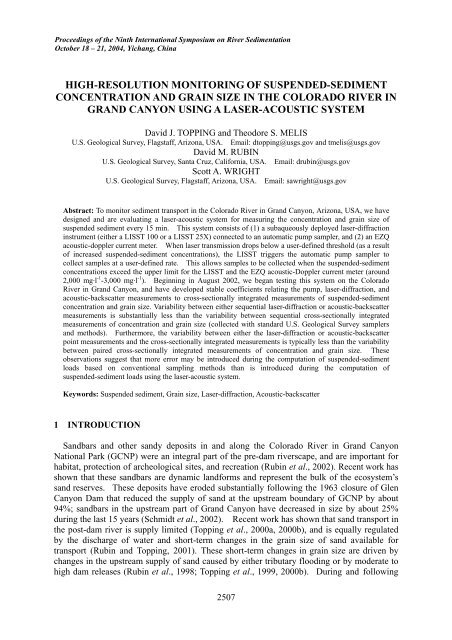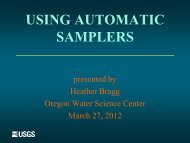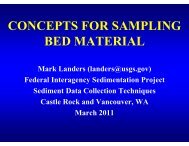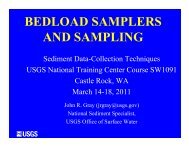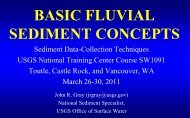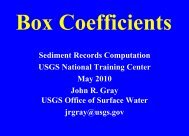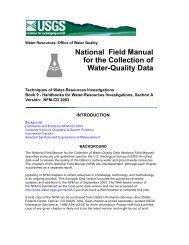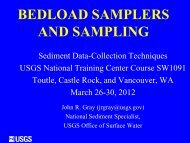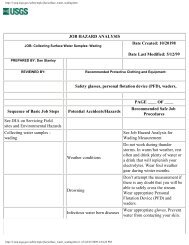high-resolution monitoring of suspended-sediment concentration ...
high-resolution monitoring of suspended-sediment concentration ...
high-resolution monitoring of suspended-sediment concentration ...
You also want an ePaper? Increase the reach of your titles
YUMPU automatically turns print PDFs into web optimized ePapers that Google loves.
Proceedings <strong>of</strong> the Ninth International Symposium on River Sedimentation<br />
October 18 – 21, 2004, Yichang, China<br />
HIGH-RESOLUTION MONITORING OF SUSPENDED-SEDIMENT<br />
CONCENTRATION AND GRAIN SIZE IN THE COLORADO RIVER IN<br />
GRAND CANYON USING A LASER-ACOUSTIC SYSTEM<br />
David J. TOPPING and Theodore S. MELIS<br />
U.S. Geological Survey, Flagstaff, Arizona, USA. Email: dtopping@usgs.gov and tmelis@usgs.gov<br />
David M. RUBIN<br />
U.S. Geological Survey, Santa Cruz, California, USA. Email: drubin@usgs.gov<br />
Scott A. WRIGHT<br />
U.S. Geological Survey, Flagstaff, Arizona, USA. Email: sawright@usgs.gov<br />
Abstract: To monitor <strong>sediment</strong> transport in the Colorado River in Grand Canyon, Arizona, USA, we have<br />
designed and are evaluating a laser-acoustic system for measuring the <strong>concentration</strong> and grain size <strong>of</strong><br />
<strong>suspended</strong> <strong>sediment</strong> every 15 min. This system consists <strong>of</strong> (1) a subaqueously deployed laser-diffraction<br />
instrument (either a LISST 100 or a LISST 25X) connected to an automatic pump sampler, and (2) an EZQ<br />
acoustic-doppler current meter. When laser transmission drops below a user-defined threshold (as a result<br />
<strong>of</strong> increased <strong>suspended</strong>-<strong>sediment</strong> <strong>concentration</strong>s), the LISST triggers the automatic pump sampler to<br />
collect samples at a user-defined rate. This allows samples to be collected when the <strong>suspended</strong>-<strong>sediment</strong><br />
<strong>concentration</strong>s exceed the upper limit for the LISST and the EZQ acoustic-Doppler current meter (around<br />
2,000 mg·l -1 -3,000 mg·l -1 ). Beginning in August 2002, we began testing this system on the Colorado<br />
River in Grand Canyon, and have developed stable coefficients relating the pump, laser-diffraction, and<br />
acoustic-backscatter measurements to cross-sectionally integrated measurements <strong>of</strong> <strong>suspended</strong>-<strong>sediment</strong><br />
<strong>concentration</strong> and grain size. Variability between either sequential laser-diffraction or acoustic-backscatter<br />
measurements is substantially less than the variability between sequential cross-sectionally integrated<br />
measurements <strong>of</strong> <strong>concentration</strong> and grain size (collected with standard U.S. Geological Survey samplers<br />
and methods). Furthermore, the variability between either the laser-diffraction or acoustic-backscatter<br />
point measurements and the cross-sectionally integrated measurements is typically less than the variability<br />
between paired cross-sectionally integrated measurements <strong>of</strong> <strong>concentration</strong> and grain size. These<br />
observations suggest that more error may be introduced during the computation <strong>of</strong> <strong>suspended</strong>-<strong>sediment</strong><br />
loads based on conventional sampling methods than is introduced during the computation <strong>of</strong><br />
<strong>suspended</strong>-<strong>sediment</strong> loads using the laser-acoustic system.<br />
Keywords: Suspended <strong>sediment</strong>, Grain size, Laser-diffraction, Acoustic-backscatter<br />
1 INTRODUCTION<br />
Sandbars and other sandy deposits in and along the Colorado River in Grand Canyon<br />
National Park (GCNP) were an integral part <strong>of</strong> the pre-dam riverscape, and are important for<br />
habitat, protection <strong>of</strong> archeological sites, and recreation (Rubin et al., 2002). Recent work has<br />
shown that these sandbars are dynamic landforms and represent the bulk <strong>of</strong> the ecosystem’s<br />
sand reserves. These deposits have eroded substantially following the 1963 closure <strong>of</strong> Glen<br />
Canyon Dam that reduced the supply <strong>of</strong> sand at the upstream boundary <strong>of</strong> GCNP by about<br />
94%; sandbars in the upstream part <strong>of</strong> Grand Canyon have decreased in size by about 25%<br />
during the last 15 years (Schmidt et al., 2002). Recent work has shown that sand transport in<br />
the post-dam river is supply limited (Topping et al., 2000a, 2000b), and is equally regulated<br />
by the discharge <strong>of</strong> water and short-term changes in the grain size <strong>of</strong> sand available for<br />
transport (Rubin and Topping, 2001). These short-term changes in grain size are driven by<br />
changes in the upstream supply <strong>of</strong> sand caused by either tributary flooding or by moderate to<br />
<strong>high</strong> dam releases (Rubin et al., 1998; Topping et al., 1999, 2000b). During and following<br />
2507
tributary floods, fine sand supplied to the Colorado River travels downstream as an elongating<br />
<strong>sediment</strong> wave. As the front <strong>of</strong> a <strong>sediment</strong> wave passes a given location, sand on the bed<br />
first fines, the <strong>suspended</strong> sand fines, and the <strong>suspended</strong>-sand <strong>concentration</strong> increases<br />
independently <strong>of</strong> the discharge <strong>of</strong> water. Subsequently, the bed is winnowed <strong>of</strong> finer sand,<br />
the <strong>suspended</strong> sand coarsens, and the <strong>suspended</strong>-sand <strong>concentration</strong> decreases independently<br />
<strong>of</strong> discharge. Consequently, sand supplied by tributaries is typically exported from the<br />
upstream part <strong>of</strong> Grand Canyon within months under normal dam releases. These coupled<br />
changes in sand <strong>concentration</strong> and grain size can occur independently <strong>of</strong> discharge and preclude<br />
the computation <strong>of</strong> sand-transport rates using stable relations between water discharge and sand<br />
transport (i.e., <strong>sediment</strong> rating curves) and require a more continuous method for measuring<br />
sand transport (Topping et al., 2000b). To continuously measure <strong>suspended</strong>-<strong>sediment</strong><br />
<strong>concentration</strong> and grain size in the Colorado River, we began testing a laser-acoustic system at<br />
the U.S. Geological Survey (USGS) Grand Canyon streamflow gaging station in August 2002<br />
(Fig. 1).<br />
37<br />
113 UTAH<br />
112<br />
ARIZONA<br />
LAKE<br />
POWELL<br />
ARIZONA<br />
GLEN<br />
CANYON<br />
DAM<br />
GRAND<br />
CANYON<br />
36<br />
GRAND CANYON GAGING STATION<br />
0<br />
km<br />
50<br />
Fig. 1<br />
Map <strong>of</strong> the Study Area showing the Location <strong>of</strong> the Colorado River near Grand Canyon, Arizona<br />
gaging Station (USGS station number 09402500)<br />
2 THE LASER-ACOUSTIC SYSTEM<br />
At the Grand Canyon gaging station test site, the laser-acoustic system consists <strong>of</strong>: (1) a<br />
Sequoia Scientific LISST (Laser In-Situ Scattering and Transmissometry)-25X(Use <strong>of</strong> brand and<br />
firm names in this paper does not constitute endorsement by the USGS.) type C laser-diffraction<br />
instrument and a Sequoia Scientific LISST-100 type C laser-diffraction instrument<br />
(http://www.sequoiasci.com/products/LISST_Inst.aspx), (2) an ISCO 6712 automatic pump<br />
sampler (http://www.isco.com/aspscripts/products3.aspPDG=201101010), and (3) a Nortek<br />
EZQ acoustic-Doppler current meter (http://www.nortek-as.com/brochures/EZQ.pdf). The<br />
ISCO pump sampler is triggered by the LISST instruments when laser transmission drops<br />
below a user-defined threshold (due to <strong>high</strong>er <strong>suspended</strong>-<strong>sediment</strong> <strong>concentration</strong>s) and then<br />
samples at a user-defined rate.<br />
The two LISST instruments are <strong>suspended</strong> in the river from a steel cable on pulleys<br />
attached to a vertical cliff. The sampling path lengths <strong>of</strong> the two LISST instruments are 1<br />
cm. The LISST-25X averages 1,000 samples collected over 110 s out <strong>of</strong> every 15 min; output<br />
is <strong>concentration</strong> <strong>of</strong> total <strong>suspended</strong> <strong>sediment</strong>, <strong>concentration</strong> <strong>of</strong> <strong>suspended</strong> sand, Sauter mean<br />
sizes <strong>of</strong> total <strong>suspended</strong> <strong>sediment</strong> and <strong>suspended</strong> sand, and laser transmission. The LISST-100<br />
averages 100 samples collected over 30 s out <strong>of</strong> every 15 m; output is <strong>concentration</strong> <strong>of</strong><br />
<strong>suspended</strong> <strong>sediment</strong> in 32 log-spaced size classes from 2.5 µm to 500 µm, water temperature,<br />
2508
pressure, and laser transmission.<br />
The ISCO 6712 automatic pump sampler has a capacity <strong>of</strong> 24 one-liter bottles. We designed<br />
the LISST-ISCO pump-sampler control circuit to allow data collection during periods when the<br />
Colorado River is so greatly enriched with <strong>suspended</strong> <strong>sediment</strong> that the LISST instruments<br />
overestimate <strong>suspended</strong>-<strong>sediment</strong> <strong>concentration</strong> owing to multiple scattering or provide no<br />
usable data owing to extremely low laser transmission. The protocol is as follows: when the<br />
measured laser transmission is less than the user-defined threshold, the LISST instrument<br />
electronically enables the automated program <strong>of</strong> the ISCO pump sampler. Once the pump<br />
sampler is activated, samples are collected from a fixed intake located near the LISST<br />
instruments at pre-defined intervals until either the measured laser transmission exceeds the<br />
user-defined threshold, or the supply <strong>of</strong> 24 one-liter sample bottles is exhausted.<br />
The 1-MHz EZQ acoustic-Doppler current meter is rigid-mounted subaqueously on a pipe<br />
attached to a vertical wall. It has two horizontal acoustic beams spaced 50 degrees apart for<br />
measuring 2-D-planform velocity using the Doppler effect, a vertical acoustic beam and<br />
pressure transducer for measuring stage, and a 45 degree downward-looking acoustic beam for<br />
measuring bed scour and fill. The beam width is 3.4 degrees. We have deployed the<br />
horizontal beams <strong>of</strong> the EZQ to measure particle counts starting 8 m from the instrument in<br />
three 5-m long cells. The EZQ averages 78,000 sampling bursts over 13 min out <strong>of</strong> every<br />
15-minute interval. The 1 MHz EZQ is acoustically sensitive to particles with diameters<br />
ranging from about 30 µm to about 600 µm (Lohrmann, 2001). Over this range <strong>of</strong> particle<br />
sizes, particle counts and <strong>sediment</strong> <strong>concentration</strong> are positively correlated. Particles smaller<br />
than about 30 µm are perceived by the EZQ to be part <strong>of</strong> the fluid. No correlation exists<br />
between particle counts and <strong>sediment</strong> <strong>concentration</strong> for particles larger than about 600 µm.<br />
3 VARIABILITY BETWEEN SEQUENTIAL CONVENTIONAL<br />
CROSS-SECTIONALLY INTEGRATED SAMPLES<br />
Prior to developing cross-section coefficients (Edwards and Glysson, 1999) relating the<br />
pump, LISST, and EZQ measurements to analytical results from conventional cross-sectionally<br />
integrated samples at the Grand Canyon gaging station, we collected paired sequential<br />
cross-sectionally integrated samples using conventional D-77 and D-96 bag samplers (Federal<br />
Interagency Sedimentation Project, 2004). This was necessary to help place constraints on<br />
whether more error may be introduced in <strong>sediment</strong> loads computed using these cross-section<br />
coefficients than is introduced in <strong>sediment</strong> loads computed using only the conventional<br />
cross-sectionally integrated samples. The results <strong>of</strong> this test indicate that, regardless <strong>of</strong><br />
sampler type, the variability between conventional cross-sectionally integrated samples is <strong>high</strong><br />
for sand <strong>concentration</strong> (with R 2 between paired samples < 0.7) and extremely <strong>high</strong> for sand<br />
grain size (with R 2 between paired samples < 0.1).<br />
4 DEVELOPMENT OF CROSS-SECTION-COEFFICIENT RELATIONS<br />
Following evaluation <strong>of</strong> the variability inherent in conventional cross-sectionally integrated<br />
<strong>suspended</strong>-<strong>sediment</strong> measurements, we developed cross-section-coefficient relations<br />
calibrating the ISCO pump-sampler measurements, and the LISST-25X and the LISST-100<br />
laser-diffraction measurements (Fig. 2) to the cross-sectionally integrated measurements <strong>of</strong><br />
<strong>suspended</strong>-<strong>sediment</strong> <strong>concentration</strong> and grain size. We found that the variability around these<br />
cross-section-coefficient relations to be typically much less than that between the paired<br />
conventional cross-sectionally integrated samples (especially for <strong>suspended</strong>-sand<br />
<strong>concentration</strong> and grain size).<br />
2509
Calibration <strong>of</strong> the EZQ acoustic-backscatter measurements to the conventional<br />
cross-sectionally integrated <strong>sediment</strong>-transport measurements was slightly more complicated.<br />
To compute both silt and clay <strong>concentration</strong>s and sand <strong>concentration</strong>s using the single<br />
frequency EZQ, we used the fact that, for the 1MHz EZQ, increases in the <strong>concentration</strong> <strong>of</strong><br />
particles smaller than about 30 µm lead to an increase in the absorption and dissipation <strong>of</strong> the<br />
acoustic<br />
Fig. 2<br />
Cross-section-coefficient relations between:<br />
(a) the <strong>suspended</strong>-silt and clay <strong>concentration</strong><br />
measured by the LISST-100 and the<br />
cross-sectionally integrated <strong>suspended</strong>-silt<br />
and clay <strong>concentration</strong>, (b) the<br />
<strong>suspended</strong>-sand <strong>concentration</strong> measured by<br />
the LISST-100 and the cross-sectionally<br />
integrated <strong>suspended</strong>-sand <strong>concentration</strong> (c)<br />
the median size <strong>of</strong> the <strong>suspended</strong> sand<br />
measured by the LISST-100 and the<br />
cross-sectionally integrated median size <strong>of</strong><br />
the <strong>suspended</strong> sand (note linear scale).<br />
energy by the fluid (relative to under clear-water conditions), and do not result in increases in<br />
the backscatter <strong>of</strong> acoustic energy. LISST-100 measurements indicate that, at <strong>high</strong>er<br />
<strong>concentration</strong>s <strong>of</strong> silt and clay, the grain size <strong>of</strong> the <strong>suspended</strong> silt and clay in the Colorado<br />
River is, in fact, predominantly finer than 30 µm; thus, changes in the <strong>concentration</strong> <strong>of</strong><br />
particles smaller than 30 µm can be used as a proxy for changes in the <strong>concentration</strong> <strong>of</strong> all <strong>of</strong><br />
the silt and clay (i.e., all particles finer than 63 µm). Because the near-surface <strong>concentration</strong><br />
<strong>of</strong> <strong>suspended</strong> <strong>sediment</strong> is approximately equal over the portion <strong>of</strong> the river sampled by the<br />
EZQ (in the region about 8m to 23 m from the instrument), we evaluated the effect <strong>of</strong><br />
temporal changes in the <strong>concentration</strong> <strong>of</strong> particles finer than 30 µm on the fluid absorption <strong>of</strong><br />
the acoustic energy by assuming that the range-normalized echo level was equal in cells 1 and<br />
3. Based on Lohrmann (2001), the range-normalized echo level, E, (in dB) in any one cell is<br />
evaluated as:<br />
2510
E = 0.43A<br />
+ 20 log10(<br />
R)<br />
+ 2α f<br />
R + 20R∫α<br />
pdr<br />
, (1)<br />
where A is the amplitude <strong>of</strong> the backscattered acoustic signal strength (in counts), R is the<br />
distance along the beam from the instrument (in m), α f is the fluid absorption <strong>of</strong> the acoustic<br />
energy (in dB·m -1 ), and α p is the attenuation <strong>of</strong> the acoustic energy by particles sensed by the<br />
EZQ (in dB·m -1 ). For the 1 MHz EZQ, if no particles finer than 30 µm are present, then α f is<br />
due to only the molecular transfer <strong>of</strong> acoustic energy to heat in water (and depends only on<br />
the salinity <strong>of</strong> the water). Since the last term in equation 1 describes the absorption and<br />
scattering <strong>of</strong> the acoustic energy by particles in the size range sensed by the 1 MHz EZQ<br />
(30µm -600 µm), we excluded this last term from this analysis. Thus, Eq. 1 was rearranged<br />
to solve for α f by setting the range-normalized echo level in cells 1 and 3 to be equal. Fig.<br />
3(a) shows the relation between α f computed by this approach and silt and clay <strong>concentration</strong>.<br />
A simpler method to capture the effect <strong>of</strong> silt and clay-<strong>concentration</strong>-driven changes in α f was<br />
to use the ratio <strong>of</strong> the amplitude <strong>of</strong> the backscattered acoustic signal strength in cell 3 to that<br />
Fig. 3<br />
(a) Power-law relation between the coefficient <strong>of</strong> fluid absorption and the cross-sectionally integrated<br />
<strong>concentration</strong> <strong>of</strong> <strong>suspended</strong> silt and clay. (b) Linear relation between the ratio <strong>of</strong> the amplitude <strong>of</strong> the<br />
backscattered acoustic signal strength in cell 3 to that in cell 1 and the cross-sectionally integrated <strong>concentration</strong> <strong>of</strong><br />
<strong>suspended</strong> silt and clay. (c) Power-law relations between the amplitude <strong>of</strong> the backscattered acoustic signal<br />
strength in cell 3 and the cross-sectionally integrated <strong>concentration</strong> <strong>of</strong> <strong>suspended</strong> sand for small ranges <strong>of</strong> the ratio<br />
in b. (d) Power-law relation between the ratio in b and the constant k in c<br />
2511
in cell 1 as a proxy for <strong>suspended</strong> silt and clay <strong>concentration</strong> (Fig. 3(b)). Then, for small<br />
ranges in this ratio (i.e., for small ranges in the <strong>suspended</strong>-silt and clay <strong>concentration</strong>),<br />
power-law cross-section-coefficient relations were developed to relate the amplitude <strong>of</strong> the<br />
backscattered acoustic signal strength in cell 3 to the cross-sectionally integrated<br />
measurements <strong>of</strong> <strong>suspended</strong>-sand <strong>concentration</strong> (Figs. 3(c)-3(d)).<br />
5 COMPARISON TO CROSS-SECTIONALLY INTEGRATED CONVENTIONAL<br />
SEDIMENT-TRANSPORT DATA<br />
After application <strong>of</strong> the cross-section-coefficient relations in section 4, the pump, LISST,<br />
and EZQ <strong>sediment</strong>-transport measurements were compared to conventional cross-sectionally<br />
integrated <strong>sediment</strong>-transport measurements, both during the period used for calibration in<br />
section 4 (through June 2003) and during the post-calibration period beginning in July 2003<br />
(Fig. 4). These comparisons suggest that the cross-section-coefficient calibration relations<br />
2512<br />
Fig. 4 (a) Comparison <strong>of</strong> measured <strong>suspended</strong>-sand<br />
<strong>concentration</strong>s during February 20-March 5,<br />
2003. (b) Comparison <strong>of</strong> measured<br />
<strong>suspended</strong>-sand median grain size during<br />
February 20-March 5, 2003. (c)<br />
Comparison <strong>of</strong> measured <strong>suspended</strong>-silt and<br />
clay <strong>concentration</strong>s during the<br />
tributary-flooding period <strong>of</strong> March 13-April<br />
3, 2003. (d) Comparison <strong>of</strong> measured<br />
<strong>suspended</strong>-sand <strong>concentration</strong>s during the<br />
post-calibration period <strong>of</strong> July 15-August 7,<br />
2003. (e) Comparison <strong>of</strong> measured<br />
<strong>suspended</strong>-silt and clay <strong>concentration</strong>s during<br />
the post-calibration period <strong>of</strong> July 15-August<br />
7, 2003
developed prior to July 2003 are stable. Thus, once calibrated, the laser-acoustic system can<br />
be used to provide continuous measurements <strong>of</strong> <strong>suspended</strong>-<strong>sediment</strong> <strong>concentration</strong> and grain<br />
size, with fewer required conventional samples for future verification <strong>of</strong> the laser-acoustic<br />
measurements.<br />
Orders <strong>of</strong> magnitude more <strong>sediment</strong>-transport measurements can be made each day by the<br />
laser-acoustic system than is possible using conventional sampling methods. Furthermore,<br />
most <strong>of</strong> the data collected by the laser-acoustic system do not have to be processed in a<br />
laboratory, as do the data collected by conventional <strong>suspended</strong>-<strong>sediment</strong> samplers. Only<br />
samples collected by the ISCO pump sampler (at <strong>high</strong>er <strong>suspended</strong>-<strong>sediment</strong> <strong>concentration</strong>s)<br />
have to be processed in a laboratory before they can be used. Thus, the laser-acoustic<br />
system allows for real-time computation <strong>of</strong> <strong>suspended</strong>-<strong>sediment</strong> <strong>concentration</strong> and grain size.<br />
For comparison, it takes approximately 2-3 days to process a <strong>suspended</strong>-<strong>sediment</strong> sample<br />
through a laboratory for <strong>concentration</strong> and grain size and, depending on laboratory workload,<br />
might result in delays on the order <strong>of</strong> months in producing the data.<br />
6 VARIABILITY BETWEEN SEQUENTIAL EZQ AND LISST MEASUREMENTS:<br />
HOW REPRESENTATIVE OF THE SEDIMENT CONDITIONS IN THE RIVER<br />
ARE THE LASER-ACOUSTIC MEASUREMENTS<br />
Analyses indicate that the variability between sequential EZQ and LISST measurements is<br />
considerably less than that between sequential conventional cross-sectionally integrated<br />
samples. This result suggests that once calibrated, the laser-acoustic system may provide<br />
more accurate measurements <strong>of</strong> <strong>suspended</strong>-<strong>sediment</strong> <strong>concentration</strong> and grain size than do<br />
conventional sampling methods. Because the volume <strong>of</strong> water sampled in the cross-section<br />
by conventional sampling methods is comparable to or smaller than the volume <strong>of</strong> water<br />
effectively sampled by the laser-acoustic system, once calibrated the laser-acoustic system<br />
may provide data that are not only more accurate, but are also more representative <strong>of</strong> temporal<br />
changes in the <strong>sediment</strong>-transport conditions in the river. Cross-sectionally integrated<br />
samples collected with conventional samplers sample 10 0 l to 10 1 l <strong>of</strong> water over 30 min. As<br />
deployed, the LISST instruments effectively sample 10 0 l <strong>of</strong> water over 100 seconds. Thus,<br />
over 30 min, the LISST instruments sample 10 1 l <strong>of</strong> water. As deployed, the EZQ effectively<br />
samples 10 7 l <strong>of</strong> water over 13 min. Thus, over 30 min, the EZQ samples 10 8 liters <strong>of</strong> water.<br />
7 CONCLUSIONS<br />
The results presented in this paper indicate that LISST laser-diffraction and EZQ<br />
acoustic-backscatter data are suitable for <strong>monitoring</strong> <strong>suspended</strong>-<strong>sediment</strong> transport in the<br />
Colorado River and suggest that these data may be used to monitor <strong>suspended</strong>-<strong>sediment</strong><br />
transport in other settings (given that deployments are carefully designed and maintained, and<br />
that sufficient calibration/verification data are collected). The laser-acoustic<br />
<strong>sediment</strong>-transport data provide a minimum <strong>of</strong> 1 order <strong>of</strong> magnitude tighter temporal<br />
<strong>resolution</strong> <strong>of</strong> <strong>sediment</strong>-transport than can be collected using conventional sampling methods.<br />
Furthermore, no laboratory analyses are required before using the laser-acoustic<br />
<strong>sediment</strong>-transport data. This allows for real-time computation <strong>of</strong> <strong>suspended</strong>-<strong>sediment</strong><br />
<strong>concentration</strong> and grain size. Laboratory analyses <strong>of</strong> conventionally collected<br />
<strong>suspended</strong>-<strong>sediment</strong> samples take days to complete. Finally, once calibrated, the LISST<br />
laser-diffraction and EZQ acoustic-backscatter data may provide a more accurate measure <strong>of</strong><br />
<strong>sediment</strong> transport than can be obtained using conventional samplers.<br />
2513
ACKNOWLEDGMENTS<br />
Funding for this study was provided by the U.S. Department <strong>of</strong> the Interior’s Glen Canyon Dam Adaptive<br />
Management Program through the USGS-Grand Canyon Monitoring and Research Center. We would like to<br />
thank Dan Hanes and John Gray for helpful comments and suggestions on the analyses presented in this paper.<br />
REFERENCES<br />
Edwards, T.K., and Glysson, G.D., 1999, Field methods for measurement <strong>of</strong> fluvial <strong>sediment</strong>: U.S. Geological<br />
Survey Techniques <strong>of</strong> Water-Resources Investigations Book 3, Chapter C2, 89p.<br />
Federal Interagency Sedimentation Project, 2004, Home page. http://fisp.wes.army.mil/<br />
Lohrmann, A., 2001 Monitoring <strong>sediment</strong> <strong>concentration</strong> with acoustic backscattering instruments: Nortek<br />
Technical Note No. 3, 5 p., downloadable from http://www.nortek-as.com/.<br />
Rubin, D.M., and Topping, D.J., 2001, Quantifying the relative importance <strong>of</strong> flow regulation and grain-size<br />
regulation <strong>of</strong> <strong>suspended</strong>-<strong>sediment</strong> transport (α), and tracking changes in bed-<strong>sediment</strong> grain size (β): Water<br />
Resources Research, Vol. 37, p. 133-146.<br />
Rubin, D.M., Nelson, J.M., and Topping, D.J., 1998, Relation <strong>of</strong> inversely graded deposits to<br />
<strong>suspended</strong>-<strong>sediment</strong> grain-size evolution during the 1996 Flood Experiment in Grand Canyon: Geology, Vol.<br />
26, p. 99-102.<br />
Rubin, D.M., Topping, D.J., Schmidt, J.C., Hazel, J., Kaplinski, K., and Melis, T.S., 2002, Recent <strong>sediment</strong><br />
studies refute Glen Canyon Dam hypothesis: EOS, Transactions, American Geophysical Union, Vol. 83, No.<br />
25, p. 273, 277-278.<br />
Schmidt, J.C., Topping, D.J., Goeking, S., Sondossi, H., Hazel, J.E., Jr., and Grams, P.E., 2002, System-wide<br />
changes in the distribution <strong>of</strong> fine-grained alluvium in the Colorado River corridor between Lees Ferry and<br />
Bright Angel Creek, Arizona, 1980s to 2001: Preliminary report to the USGS Grand Canyon Monitoring and<br />
Research Center, Flagstaff, Arizona.<br />
Topping, D.J., Rubin, D.M., and Vierra, Jr., L.E., 2000a, Colorado River <strong>sediment</strong> transport 1. Natural<br />
<strong>sediment</strong> supply limitation and the influence <strong>of</strong> Glen Canyon Dam: Water Resources Research, Vol. 36,<br />
p.515-542.<br />
Topping, D.J., Rubin, D.M., Nelson, J.M., Kinzel, III, P.J., and Bennett, J.P., 1999, Linkage between grain-size<br />
evolution and <strong>sediment</strong> depletion during Colorado River floods, in Webb, R.H., Schmidt, J.C., Marzolf, G.R.,<br />
and Valdez, R.A., eds., The 1996 controlled flood in Grand Canyon: Washington, D.C., American<br />
Geophysical Union, Geophysical Monograph 110, p. 71-98.<br />
Topping, D.J., Rubin, D.M., Nelson, J.M., Kinzel, III, P.J., and Corson, I.C., 2000b, Colorado River <strong>sediment</strong><br />
transport 2. Systematic bed-elevation and grain-size effects <strong>of</strong> sand supply limitation: Water Resources<br />
Research, Vol. 36, p. 543-570.<br />
2514


